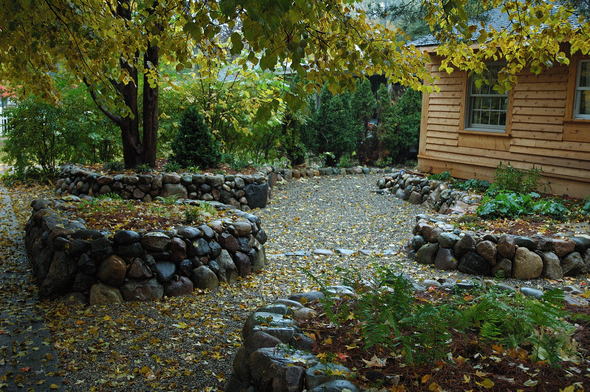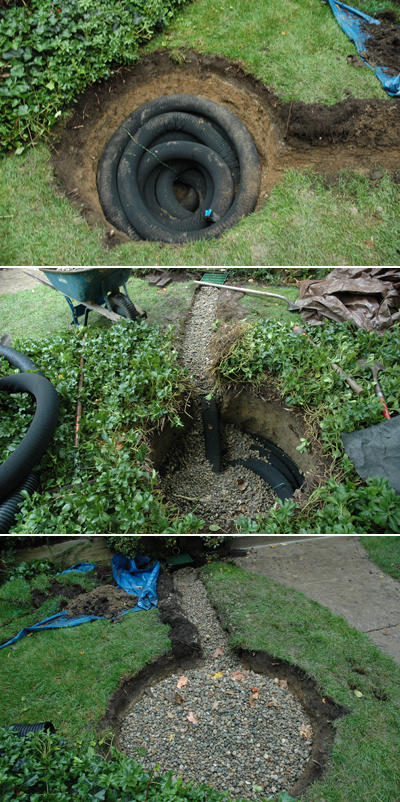Rainwater doesn't have to go down the drain: Rain gardens to the rescue

Craig Terrell, owner of Land Architects, created permeable gravel paths and terraces in the garden outside his Ann Arbor office, where the roof and driveway water flows and eventually ends up in the garden. The raised beds were made from locally procured Michigan fieldstone. The ferns in the foreground raised bed are native plants to Michigan as well.
Photo courtesy of Land Architects
Capturing and reusing rainwater also prevents it from being washed into storm sewers, said Jeremy Christianson, owner of Michigan Landscape Design Services in Plymouth. Rainwater that runs into the storm sewers collects fertilizers, animal waste, gasoline and motor oil and other pollutants along the way that eventually end up in the Huron River and beyond.
“Runoff water can be collected, held and used for plants or filtered back into the ground,” Christianson said. “It doesn’t have to tax the storm sewer system.”
That can be done by limiting the size of lawns, directing rainwater that flows off roofs and other hard surfaces, creating porous surfaces, and selecting the right plants.
Solid surfaces don’t have to create runoff, said Craig Terrell, owner of Land Architects in Ann Arbor. There are permeable pavers, concrete and even asphalt, but preparation is key.
Soil and clay should be excavated and a three-tier base of rocks (with 2- and 3-inch rock as the base, layered with progressively smaller rock) should be installed, creating storage pockets for the water.
Terrell created permeable gravel paths and terraces in the garden outside his Ann Arbor office, where the roof and driveway water flows and eventually ends up in the garden.
Turf should also be limited, Terrell said. Lawns, compacted by foot traffic and lawn mowers, soak up relatively little rainwater.
“Grass has shallow roots, runoff rates are high and lawns don’t absorb as much as perennials and mulched beds,” he said. 


To fix a home with water in the basement, Land Architects installed infiltration basins away from the foundation of the house. Each downspout from roof water drained into its own infiltration basin where the water accumulates during a storm, infiltrating into the ground instead of the basement walls.
Photos courtesy of Land Architects
“People rake their leaves out of their garden, I do the opposite,” he said. “It’s the natural mulch.”
It’s important that the leaves aren’t too thick to smother growth, he said.
“Leaves will decompose on their own, and leaving them is a lot less work.”
Terrell said he uses purchased mulch until a garden fills in, but tries to avoid hardwood mulch.
“Pine needle mulch decomposes slowly, it stays in place and it’s more sustainable than hardwood,” he said.

Rainwater that can’t be used quickly can be captured and stored. While Terrell isn’t a big fan of rain barrels - they only catch a small portion of the rain - he advocates below ground storage tanks, where the water can be used for irrigation at a later date.
Rather than creating one large rain garden for a homeowner, Christianson said he prefers to create a series of smaller gardens. It makes maintenance easier, he said.
It begins with calculating the size that’s needed to manage the runoff then backfilling the soil with compost (which acts like a giant sponge to hold the water), topsoil and native soil. The land is sculpted so runoff makes its way to the rain gardens, and underground drainage pipes are used when needed.
It’s best to plant rain gardens in sunny locations where the rainwater will more quickly evaporate, Christianson said, but shaded rain gardens are possible.

It’s important to select the right plant material for a rain garden. While the shade and sun needs of plants are important, rain garden plants must be able to tolerate moist soils for short periods but survive in dry soil in between rains.
Good rain garden plants for sunny locations include purple coneflower, Black-Eyed Susan and a number of ornamental grasses, Christianson said. Day lilies and viburnum are good choices for shade or sun.

Rain gardens aren’t limited to ground surfaces, Christianson said.
There are “live walls,” retaining walls created with pockets of soil for ground-cover plants such as sedum or vinca vine. He installed a 12-foot-high by 115-foot long living wall last year.
They can take three or four years to grow in, he said, but will eventually become a solid wall of green. While they collect storm water, the live walls have the added benefit of diffusing heat.
“A green wall (as compared to a standard concrete retaining wall) will help reduce the heat island effect,” Christianson said.


While rain gardens have been popular in Europe, they are just coming into their own in the United States, Christianson said.
“It’s not a fad. They will be commonplace soon, but they are in their infancy stage now.”
Later this summer, Christianson will present a workshop at the Ann Arbor Ecology Center about rainwater harvesting. A specific date has not been scheduled.


Comments
Epengar
Fri, Apr 23, 2010 : 1:13 p.m.
The City of Ann Arbor will give a modest credit towards water bills for property owners (both residential or commercial) that install rain gardens or rain barrels, or even just take the RiverSafe Homes survey that the County runs. This page has more information and links to other rain garden resources. http://www.a2gov.org/government/publicservices/systems_planning/waterresources/Pages/ResidentialRatesCredits.aspx If this long link doesn't work, try http://www.a2gov.org/storm and look for the residential credits page.
Epengar
Fri, Apr 23, 2010 : 1:04 p.m.
The City of Ann Arbor will give a modest credit towards water bills for property owners (both residential or commercial) that install rain gardens or rain barrels, or even just take the RiverSafe Homes survey that the County runs. This page has more information and links to other rain garden resources. http://www.a2gov.org/government/publicservices/systems_planning/waterresources/Pages/ResidentialRatesCredits.aspx If this long link doesn't work, try http://www.a2gov.org/storm and look for the residential credits page.
Epengar
Fri, Apr 23, 2010 : 1 p.m.
Harry, I submitted a comment last night that linked to your site too, and to the City of Ann Arbor's stormwater and raingardens page as well. It was held for moderation, and apparently not posted.
Harry Sheehan
Fri, Apr 23, 2010 : 9:01 a.m.
The Washtenaw County Water Resources Commissioner has been offering rain garden assistance since 2005. For more information, email sheehanh@ewashtenaw.org or visit: http://www.ewashtenaw.org/raingardens
PittsfieldTwp
Thu, Apr 22, 2010 : 9:16 a.m.
I am trying to figure out a fix on our drainage as well. I am considering rain barrels, but like the article states, they fill up fast during hard rains and then you still have to deal with over-flow unless you want to rig 2-3 barrels together which looks like, well, 3 barrels in your garden. I have seen the idea of a rain garden before, but what keeps me from doing this myself is "disposing" the clay. Diging a hole like that is difficult, and you can't just spread the clay around your garden. You have to get rid of it some how. A common problem in this area.
Barb
Thu, Apr 22, 2010 : 8:53 a.m.
This is really inspiring. I have a rain barrel but I'm going to divert some rain spouts as well this spring.
Theresa Taylor
Thu, Apr 22, 2010 : 8:51 a.m.
THANK YOU! My husband and I were just talking about how we should go about doing this.